Katherine Langrish's Blog, page 43
August 19, 2011
Fairytale Reflections (31) Candy Gourlay

Candy Gourlay was a young journalist writing for the opposition during the dictatorship of Ferdinand Marcos in the Philippines. After the revolution that toppled Marcos, she moved to London with her English husband and, as she says, 'attended to dictators of the nappy-clad variety before trying my hand at children's fiction.'
Her debut novel, 'Tall Story', published in 2010, is the story of two children. Andi lives in London, and she has two big wishes. Mum and Dad simply don't realise how important it is - but Andi is desperate to play on the basketball team of her new school. She may be small, but she's good and she knows it. But guess what? They only take boys.
Andi's other big wish is that her sixteen year old half-brother, Bernardo Hipolito, could come and live with them. Although she can hardly remember him, she would love to be his little sister - if only the Foreign Office would grant him a visa. And finally, after years of waiting, this wish comes true. As Bernardo's plane arrives from the Philippines, Andi hopes he'll turn out to be tall and just as mad as she is about basketball. And Bernardo turns out to be tall, all right. But he's not just tall ... he's a GIANT.
Candy's story isn't only a tender and touching tale of clashing expectations and cultural differences. Woven into the narrative are many of the folktales and fairytales of the Philippines. Brought up by his uncle and aunt in the tiny mountain village of San Andres, Bernardo is named after a local folklore hero, the giant Bernardo Carpio, who was big enough to plough fields with his comb and carve mountains with his fingers. One day, when an earthquake split the land open, Bernardo Carpio jumped into the fissure and braced his arms to prevent the two walls of rock from colliding. The earth swallowed him, but the village was saved.
That was long ago, but in this earthquake-prone area, earth tremors are a continuous hazard, and the village of San Andres gets into the World Records Website as 'the Land of Rock and Roll' with seismographs registering hundreds of tremors a day.
Superstition and fear rule the village in the person of Mad Nena, the village witch and her daughter Gabriela. It's the sort of place where, though people may be kind, they are also ignorant. And they are poor: and medicine is expensive. A case of rabies is treated with charms, and young Bernardo is allowed to grow taller and taller without ever being taken to a doctor: because
... imagine what a big deal it was when people discovered a boy amongst them named Bernardo who was shooting up like a giant bamboo.
And imagine what they thought when, as the boy grew, the rock and roll dwindled to a full stop.
And then imagine how they would feel if they knew their saviour was about to leave them to their fate.
Tall Story has been shortlisted for eleven children's book prizes including the Waterstone's, the Branford Boase and the Blue Peter prize. It won the Crystal Kite Children's Book Prize for Europe. Her next book, 'Shine', will be published in 2012...
Now I'm a big fan of oral storytelling as well as the written down variety. So here is Candy, a woman of many talents, with some tantalizing glimpses of stories from the land of her birth - and one in particular:
The Legend of the Pineapple
Are there such things as fairy tales in the Philippines where I grew up?
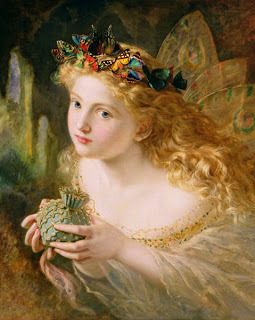
By Sophie Anderson (Wikimedia Commons)
If a fairy tale requires a fairy, then no - we don't have wand-wielding, tutu-wearing creatures in our woods (I would say rain forests, except most of those have been chopped down).
What's in a fairy tale? Magic, certainly. An evil power perhaps - wicked stepsisters, witches, magic foul versus heroine fair. A resolution that involves come-uppance? Happily ever afters?
I thought the best way to reflect on this subject was to do my own re-telling of a Filipino sort of fairy tale ... so here is my video re-telling of The Legend of the Pineapple, an old Filipino story.
I made the video with the help of my young neighbours, Christiane and Jacob (Jacob very kindly agreed to be the voice of a little girl as long as I used his drawing of a jet plane - watch out for it!):
The Legend of the Pineapple from Candy Gourlay on Vimeo.
I grew up listening to stories like these told by my parents usually during the frequent evening power cuts that plagued my childhood in Manila. We would light candles and katol (an incense like mosquito repellent) and sit around the dining table telling stories until the power cuts were over.
The stories were always about everyday things - the turtle, that mountain we always drove past, that plant with leaves that folded when touched ... but unlike the happily ever afters of Western fairy tales, the endings always had a sadness to them.
A man turned arrogant and overbearing by his rapid success, turns into the shamefully slow turtle. (The Legend of the Turtle)

Maria Makiling (Photo: Life Expressions blog)
A young woman, abandoned by her lover, falls into an eternal sleep - and will forevermore be a mountain. (The Legend of Maria Makiling)

Makahiya plant (Sensitive Plant)
A painfully shy child trying to overcome her shyness ventures out only to be crushed by cruel strangers. She turns into the makahiya, a grass-like creeper whose leaves shrink away and fold when touched. (The Legend of the Makahiya)
Yes, there is magic but there is a helplessness in the face of greater, unstoppable powers in these stories. And inevitably it's not good magic, but bad.
The Philippines is a country always on alert for disaster - year after year, typhoons sweep in without fail, floods ruin crops, earthquakes, tsunamis, volcanoes ... living with constant catastrophe has invested the culture with a diffidence - bahala na ("Let it be" or "God wills it") is a common expression. Catholicism (we are the only Catholic country in Asia) exacerbates this fatalism.
Here's a video reflection I made about the 2009 deluge in the Philippines: (you don't have to watch the whole thing)
(With thanks to Geraldine McCaughrean who wrote Not the End of the World)
The odd thing is when I was a child, I don't think I regarded these magical stories as fairy tales. With disaster so much a part of the fabric of life, they just seemed too real to be fairy stories.
I found my old school primer the other day from when I was seven years old.
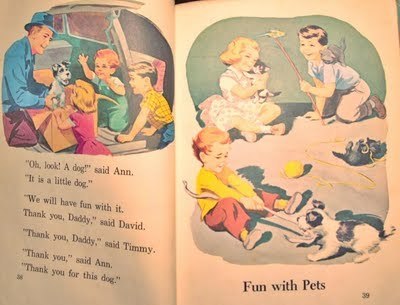
The Cathedral Reader series, with Ann, David, little Timmy and their fluffy pets who lived on clean roads with white picket fences
Now I didn't question the provenance of these stories or the other stories I read in books - the ones about Cinderellas, witches, evil stepmothers and the like.
There wasn't a lot of publishing (and very few books for children) in the Philippines at the time. Most books were imported from America and Britain.
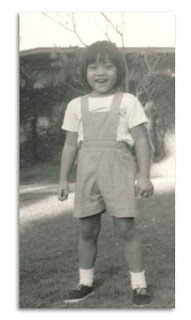
Six year old me.
The world of reading, for me, was about somewhere else. In those books, nowhere looked like home, and nobody looked like me - not even in one of my favourite picture books, The Five Chinese Brothers!
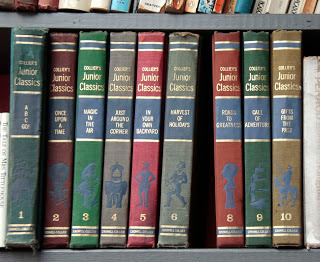
Most of my reading came from bound collections like these, courtesy of door-to-door salesmen selling encyclopedias and other bound collections that we paid for by installment. I've kept the old collection that I read as a child and dip into them to this day.
It was all fantasy. Everything I read was a fairy tale.
It was only when I came to live here in Europe that I discovered there really were castles and hundred acre woods and foxes and kings and twisty-turny cobbled alleys and Black Forests. It takes a big leap for me to think that those fairy tales I read as a child were based on real places and possibly real people.
Huh. So those storytellers of long ago were writing about themselves.
And perhaps their readers were thinking: these stories are too close to the bone to be fairy tales.
Published on August 19, 2011 00:57
August 12, 2011
Fairytale Reflections (30) Fiona Dunbar
 So you're looking for an author who writes adventure stories – and I mean adventures – with brilliant main characters who more often than not just happen to be female? You are looking for Fiona Dunbar. There is no earthly reason (other than adult-generated prejudice) why boys as well as girls shouldn't enjoy her books. Her writing fizzes with energy and ideas and fun: she blithely ignores boundaries between genres, and I'm particularly addicted to her 'Silk Sisters' trilogy, beginning with 'Pink Chameleon', set a decade or two into the future, a wildly funny yet thought-provoking mixture of science fiction and – believe it or not – fashion. (Just how far can genome research and nano-technology take us? What if you really ARE what you wear?)
So you're looking for an author who writes adventure stories – and I mean adventures – with brilliant main characters who more often than not just happen to be female? You are looking for Fiona Dunbar. There is no earthly reason (other than adult-generated prejudice) why boys as well as girls shouldn't enjoy her books. Her writing fizzes with energy and ideas and fun: she blithely ignores boundaries between genres, and I'm particularly addicted to her 'Silk Sisters' trilogy, beginning with 'Pink Chameleon', set a decade or two into the future, a wildly funny yet thought-provoking mixture of science fiction and – believe it or not – fashion. (Just how far can genome research and nano-technology take us? What if you really ARE what you wear?)Or there's her Lulu Baker books which combine fairytales, skulduggery and cookery… or 'Toonhead', in which ten year old Pablo (so named by fond arty parents who hope for a budding Picasso) discovers he can predict the future through the cartoons he draws – a skill which gets him kidnapped…or her most recent title, 'Divine Freaks', featuring the irrepressible Kitty Slade, whose talent for seeing ghosts (inherited from her mother) soon leads her into no end of trouble involving a dodgy landlord who wants to evict her family, a scalpel-wielding ghost in the school biology, a back-street taxidermist, shrunken heads, and a fraudulent antiques business.
One of the things I like most about Fiona's books is that her heroines – or the occasional hero – don't exist in a vacuum. Family is important. The Silk Sisters are desperate to find their missing parents, and the bond between responsible elder sister Rory and her strong-willed little sister Elsie is both funny and touching. In 'Divine Freaks', Kitty can rely on her brother and sister for backup, while her Greek grandmother Maro is a reassuring if eccentric presence. This helps steady the reader's nerves through some of the more exciting passages… as here, when Kitty and her brother and sister secretly enter the taxidermist's house:
Those knives for slicing open a man's skull, those needles for sewing up the lips. Just what kind of skins had we seen? And now I thought about the large pots in the kitchen, large enough to contain a whole head…
I steadied myself on the stack of tea chests. "What is Eaton involved with?"
"Does this mean he's killing people?" asked Flossie…
Sam's white face was now glistening with seat. "Wait… not so fast! There has to be some rational explanation for all this."
There was a click. Followed by a humming sound. We all jumped. Then I realised it was coming from a small fridge in the corner that none of us had noticed before.
We all stared at it. "OK," I said. "Who's brave enough to look in there?"
Oh, and before I forget, the ghosts are real ghosts, the magic is real magic. Fantasy meets adventure meets horror meets science fiction. What's not to like? If you have a ten-to-fourteen year old in your life, get them one of these books immediately! Meanwhile, here is Fiona to talk about one of the old favourites -
CINDERELLA
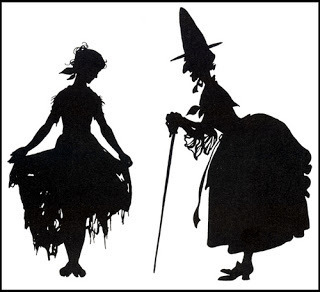
Hands up who thinks Cinderella is a rather nauseating goody-two-shoes. Just in case there's any uncertainty, I'm talking about the Cinderella who not only puts up with systematic abuse from her stepfamily without ever standing up for herself, but endures it all with a sweet smile. The one who never once talks to her father about this abuse, and who actually helps her sisters get themselves all tarted up in their finery, while she is dressed in rags. That Cinderella. Oh, you too? Uh-huh.
It's all Charles Perrault's fault. Well, not entirely. But only in his version does Cinderella not even ask to go to the ball. Only in his version – and any others based on it – does Cinderella match her two stepsisters up with members of the Prince's court. A triple wedding takes place, and the sisters and their consolation prize husbands get to have their own quarters at the royal palace.
Now, I'm all for forgiveness, and I can't say I prefer the comeuppance the sisters get in Aschenputtel, the Grimm brothers' version – the pecking out of their eyes. But even so, that Perrault ending always bothered me as a child. So the mean, selfish people get to have a happy-ever-after as well, do they? So being nice and good: we needn't bother with that, then? Waste of time, is it? Of course I'm being facetious, but let's face it, children are naturally selfish creatures, and altruism is learned. And frankly, if we imagine Cinderella, the Sequel, it's hard to picture those two suddenly being transformed into gracious human beings. A more likely scenario would contain enough tragic horrors to fill a tabloid newspaper for years: infidelity (their husbands were picked for them! They never actually fancied them), alcoholism (drowning their sorrows, being confronted daily with the awful reality that they will always be the supporting cast, never the stars), vindictive behaviour (unending efforts to drag Cinderella down to their level), assorted other addictions (shopping, gambling, drugs, dieting, cosmetic surgery…)
Ah yes, the cosmetic surgery. That's another thing that features in Grimm, but not in Perrault. That cutting-off of bits of the feet, in an effort to squish them into that tiny slipper. It is a wonderfully gruesome image, with the blood oozing out (again, it is only in Perrault that the slipper is made of that transparent and incidentally impossibly brittle material, glass). Although Perrault's tale pre-dates Grimm by over a hundred years, both were drawing on a traditional tale thousands of years old, and I suspect that the prevalent European versions would have been along the lines described by the Grimms.
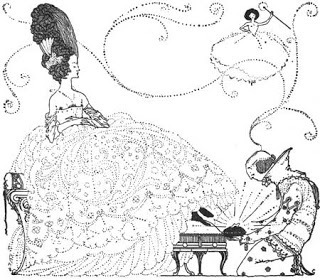
Eastern versions are less brutal than that of the Grimm brothers. Interestingly, the Chinese version, Ye Xian (AD 850) does not contain any kind of foot mutilation – interesting, of course, because you would think it might, given the appalling Chinese tradition of foot binding. Although this practice seems not to have been introduced until about a hundred years later (during the Southern Tang dynasty, AD 935-975), the idea that tiny feet were considered desirable in a woman was clearly already prevalent. Yet there is no cutting-off of toes here.
This brings me to the second element that bothered me as a child: how the hell Cinderella could be the only one in the entire kingdom with a foot small enough to fit into it.
I mean, come on! Most western females are somewhere between a size 4 and a 7. Some take a size 3; there was a time long ago, when I could just fit into a size 2 ½, but I'm sure I wasn't the only one. What size was she, for heaven's sake?
The Chinese version has a way round this plot issue which makes a lot of sense to me: the slipper is magical. It knows who it belongs to, and can change its size every time anyone other than Ye Xian tries it on, so that it is always just too small. And it makes sense that the slipper is magical, because it was supplied by the magical fish that fulfils the role played by the Fairy Godmother in the Perrault version. Sometimes the introduction of magic can seem like a cop-out: not in this case. I think there is a greater internal logic to it.
The reason I chose Cinderella for my fairytale reflection is that my Lulu Baker trilogy, about a girl with a magic recipe book, has been described as a kind of modern Cinderella story. There are some very obvious reasons for this: Lulu is the only child of a widower, and her nemesis is the new love of his life, Varaminta le Bone – whom he is all set to marry. Varaminta is a glamorous forty-something ex-model with a ghastly son called Torquil. Both Varaminta and Torquil are charm itself around Lulu's Dad, but vicious towards Lulu whenever he's not around. Which reminds me: I haven't even had a bitch about Cinderella's dad yet! Must put that right.
What about the dad, eh?
That spineless wimp who just lets those domineering females rule the roost, either unaware of how they're treating Cinderella, or worse, noticing it but failing to do anything about it. What a waste of space! Admittedly, the dad in my Lulu Baker books is completely blind to Varaminta's faults, but I do explain his lack of involvement by making him extremely busy and away on business a lot of the time. I hope he comes across as reasonably sympathetic.
As well as the obvious parallels though, I discovered other similarities while researching this piece that I didn't expect to find. For example, in the Basile version, Cenerentola (1634), there is a magical date tree; Cenerentola nurtures this tree, placing it in a golden bucket, hoeing the earth around it with a golden hoe, and wiping its leaves with a silken napkin. She is rewarded for her efforts when it grows prodigiously, and a fairy appears – the fairy godmother figure. This is similar to the way in which a magical bird emerges from the hazel tree in the Grimm brothers' Aschenputtel. In the second and third of my Lulu Baker books, Lulu grows some of the magical ingredients for her recipes in her own garden.
Cassandra, a kind of real-life fairy godmother, does not emerge from a plant, however; she is the one who supplies the ingredients, and the seeds for the ones that Lulu must grow. Lulu even has to fertilize one of them with her own tears (which she finds a considerable challenge, even with the help of onions). I based this element on the ancient Sumerian story of Inanna, but Aschenputtel also fertilizes her hazel tree with her tears.
It could also be argued that the Grimm brothers' heroine is a bit more proactive than Perrault's. Early on in the Aschenputtel story, we have the following scene:
It happened that the father was once going to the fair, and he asked his two step-daughters what he should bring back for them. 'Beautiful dresses,' said one, 'pearls and jewels,' said the second. 'And you, Cinderella [Aschenputtel],' said he, 'what will you have?' 'Father, break off for me the first branch which knocks against your hat on your way home.'
This is interesting, because there are two possibilities as to why she has chosen this. The obvious reason is that she simply wants something to plant at her mother's grave – which is what she does. This is where she weeps tears of grief onto the plant. So, yet another demonstration of her simple, virtuous nature: nothing more. Or is it? What if she knew that by tending the sapling lovingly, she would ultimately reap far greater rewards than the vulgar finery demanded by her greedy stepsisters? After all, she does go on to ask the tree outright for riches:
"Shiver and quiver, little tree,
Silver and gold throw down over me."
 Seems to me she had an inkling the hazel would have supernatural properties. Hey, good for her. She shows a bit more character than Perrault's Cinderella, who would never presume to ask for anything – heaven forfend! Aschenputtel also asks help from the pigeons and the turtle doves in picking out the lentils her stepmother has thrown into the hearth. So I prefer to interpret her action as proactive, not only outwitting her stepsisters, but also demonstrating that slow, dedicated work might just be a better approach to life than stamping your foot and demanding things very loudly.
Seems to me she had an inkling the hazel would have supernatural properties. Hey, good for her. She shows a bit more character than Perrault's Cinderella, who would never presume to ask for anything – heaven forfend! Aschenputtel also asks help from the pigeons and the turtle doves in picking out the lentils her stepmother has thrown into the hearth. So I prefer to interpret her action as proactive, not only outwitting her stepsisters, but also demonstrating that slow, dedicated work might just be a better approach to life than stamping your foot and demanding things very loudly.But there are probably as many differences as there are similarities between Cinderella and my Lulu Baker. For instance:
- Unlike Cinderella, Lulu isn't perfect. She blunders into things, makes mistakes. And if she's the victim of injustice, she sure as hell makes a noise about it! Meek she is not.
- Unlike Cinderella, Lulu is not beautiful. This is absolutely central to the story. Nor is she especially bothered about how she looks. She's a bit lazy in that department, because her head is usually somewhere else. Cinderella, Snow White, Sleeping Beauty… the list of fairytale heroines whose physical beauty is a metaphor for their inner virtue – yawn – is endless. But where are the merely OK-looking ones? The ones whose best qualities lie in other areas – like being, say, fun to be around. A good laugh. Someone you might actually want as a friend. Hard to find, right?
- Unlike the Cinderella story, which is primarily about sibling rivalry, the main enemy in the Lulu stories is the stepmother figure. This is mostly because Lulu is younger than Cinderella: life is not yet about competing with contemporaries for romantic attention. True, she has a new stepbrother to contend with, but while he may be deeply unpleasant, he is not a direct competitor the way that Cinderella's stepsisters are.
- Unlike the Cinderella story, it is the stepmother figure that gets her comeuppance – logical, since she is the main enemy. Even in the Grimm version, it is only the stepsisters that have their eyes pecked out; their mother escapes this fate. And after all, where marrying off daughters is a means of survival, or a dowry has to be provided, being a stepmother must be a most unenviable situation, laden with moral complexity. For most modern-day western stepmums, this is not the case. Varaminta, therefore, embodies all the characteristics of the stepsisters, as well as those of their mother.
All right, enough about 'my' Cinderella. Possibly you know of other modern Cinderellas – perhaps ones that are simpler tellings based on tradition that have altered the story according to the dominant philosophy of our time. Because let's face it, Christanity, which provides the moral code for both Grimm and Perrault, arguably holds less sway today than it did then. Ye Xian's story is influenced by religion of its time and place, as is the earliest known version of the Cinderella story, Rhodopis (Strabo, 1st century BC – though also mentioned by Herodotus five centuries earlier). I hate to say it, but perhaps what we have today is a sort of Christianity Lite. Or rather, Abrahamic-Religion-Lite. The Ten Commandments are good, they are right, but we're not really bothered about taking the Lord's name in vain, and can we please not have to stay in on the Sabbath as we'd rather go shopping. Also, loving our enemies is a bit hard. Thanks.
Depressing, isn't it? But don't get me started. Anyway I can't assume the moral high ground here: if I adhered wholeheartedly to the Christian ideal, I would love and revere the character of Perrault's Cinderella, and I don't.
So: who would you pick as a Cinderella for our times, and why?
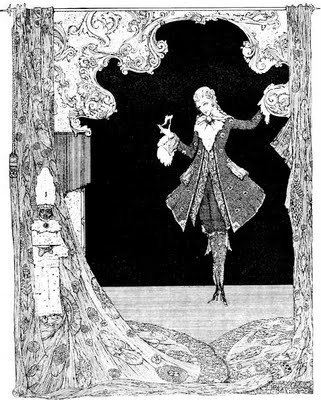
Picture credits:
Cinderella and her Godmother: silhouette by Arthur Rackham
Trying on the Shoe by Aubrey Beardsley
Aschenputtel by Alexander Zick (1845 - 1907) Wikimedia Commons
Cinderella: The Glass Slipper by Kay Nielsen
Published on August 12, 2011 04:21
And the winners are...
Thanks to all of you who visited the trailer and left comments! The winners of the three signed copies of Dark Angels are:
Teleri
Anonymous (Barbara M)
Swan Artworks
If you'd like to email me ( I'm changing the @ sign here to deter spam, but you can replace it) katherinelangrishATgooglemail.com - with your addresses, I'll send out the copies asap.

Teleri
Anonymous (Barbara M)
Swan Artworks
If you'd like to email me ( I'm changing the @ sign here to deter spam, but you can replace it) katherinelangrishATgooglemail.com - with your addresses, I'll send out the copies asap.
Published on August 12, 2011 04:14
The Dark Angels Book Trailer Giveaway!
The countdown has started! In just about three hours, at 12 noon UK time, we'll be finding out who has won three signed copies of 'Dark Angels'! All you have to do, if you haven't already, is watch the Dark Angels trailer and comment either on Youtube, or here on the blog - and in three hours time I'll be announcing the winners. There's also a competition for another three copies on twitter: visit me at http://twitter.com/#!/KathLangrish and retweet my competition tweets.
Here's the trailer again:
With all your help, it's been viewed over 470 times this week, and I have to admit I'd love to get it up to 500... And Fairytale Reflections will be back this afternoon, after the winners are announced, so please come back and visit then, too!

Here's the trailer again:
With all your help, it's been viewed over 470 times this week, and I have to admit I'd love to get it up to 500... And Fairytale Reflections will be back this afternoon, after the winners are announced, so please come back and visit then, too!
Published on August 12, 2011 01:03
August 5, 2011
Dark Angels - Competition and Book Trailer
Please excuse my excitement. (And the interruption to Fairytale Reflections, which will be back next week.)
The fact is I'm jumping up and down, because my home-made booktrailer for my fourth book, 'Dark Angels' (US title 'The Shadow Hunt') went up on Youtube yesterday. To celebrate, I'm launching a COMPETITION to win three signed copies of 'Dark Angels'. All you have to do to enter, is view the trailer and leave a comment about it either on Youtube or here on the blog. Look out also for a parallel competition on twitter. Both will run until next Friday, August 12th, when there'll be a draw for the winners.
.
The book is set on and around the sinister, atmospheric Shropshire hill which in real life is called 'Stiperstones'(and is pictured at the top of my blog). In my book I renamed it 'Devil's Edge.' The real hill has a formation of rocks on the crest known as The Devil's Chair: the legend goes that the Devil comes to sit in it when the mist descends on the hill (so you'd better beware); and if anyone else sits in it, an immediate thunderstorm will break out. I took the liberty of changing this slightly:
Wolf took another glance at the ridge. Up on the very top, he had heard there was a road. A road leading nowhere, a road no one used. For if anyone was so bold as to walk along it, especially at night, he'd hear the clamour of hounds and the blowing of horns, the cracking of whips and the rumbling of a cart. And out of the dark would burst the Devil's own dog pack, dashing beside a black wagon drawn by goats with fiery eyes, crammed full of screaming souls bound for the pits of hell.
So off I went to Shropshire with a notebook and camera. We stayed, in case anyone is interested, in the quaint little market town of Bishop's Castle, and we tramped over Stiperstones in rain, in mist, and in sweeping wind. We visited a wolf sanctuary set in a narrow little valley – it began to snow as we descended the steep track, and I'll never forget the snow falling precipitously past the dark serried ranks of fir trees, and the wolves howling in the winter landscape. We climbed the grassy mound which is all that's left of the 11th century Montgomery stronghold of Hen Domen – the motte and bailey castle replaced by the stone fortress at Montgomery. Neither were right for the filming: in the end we chose the oldest parts of nearby Stokesay Castle.
And on a later trip, courtesy of a Shropshire mining and caving club, we crawled into the tight dark passages of an abandoned Roman copper mine, which became the entrance to elfland in my book. It was very narrow and low: we went in on hands and knees: at one point you had to lie down. I'm not good in narrow spaces, so this shows what I will do in the interests of research. I wanted the underground sequences in my book to be truly authentic: I wanted the reader to feel as pinched and constrained as I was. The cave is called Ogof Llanymynech and may go as far back as the Bronze Age. A hoard of Roman coins was found there in 1965. (I love the sense of deep time in the British landscape.)
So the landscape of my story is a patchwork of real locations pieced together, recognisable as the Welsh Marches, but renamed and reshaped so that I had the freedom of fiction as well as – I hope – a sense of real history and place.
Writing the script for the trailer was almost like composing a poem: distilling the essence of a 65,000 word book into 100 words. In fact the whole process was very like making poetry, trying to combine evocative words, imagery and sound. Anyway, here you can see all the elements I wove together in the book. The stark skyline of 'Devil's Edge', the rough moorland, the lonely castle, the claustrophobic darkness of the mine. Listen carefully and you may even hear wolves.
My thanks to Richard Hughes of the band We Are Goose, who composed and performed the haunting music, and edited and assembled the film.
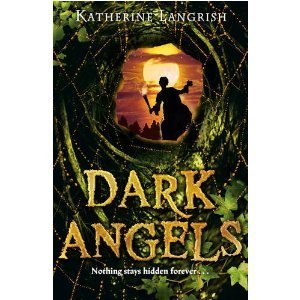

The fact is I'm jumping up and down, because my home-made booktrailer for my fourth book, 'Dark Angels' (US title 'The Shadow Hunt') went up on Youtube yesterday. To celebrate, I'm launching a COMPETITION to win three signed copies of 'Dark Angels'. All you have to do to enter, is view the trailer and leave a comment about it either on Youtube or here on the blog. Look out also for a parallel competition on twitter. Both will run until next Friday, August 12th, when there'll be a draw for the winners.
.
The book is set on and around the sinister, atmospheric Shropshire hill which in real life is called 'Stiperstones'(and is pictured at the top of my blog). In my book I renamed it 'Devil's Edge.' The real hill has a formation of rocks on the crest known as The Devil's Chair: the legend goes that the Devil comes to sit in it when the mist descends on the hill (so you'd better beware); and if anyone else sits in it, an immediate thunderstorm will break out. I took the liberty of changing this slightly:
Wolf took another glance at the ridge. Up on the very top, he had heard there was a road. A road leading nowhere, a road no one used. For if anyone was so bold as to walk along it, especially at night, he'd hear the clamour of hounds and the blowing of horns, the cracking of whips and the rumbling of a cart. And out of the dark would burst the Devil's own dog pack, dashing beside a black wagon drawn by goats with fiery eyes, crammed full of screaming souls bound for the pits of hell.
So off I went to Shropshire with a notebook and camera. We stayed, in case anyone is interested, in the quaint little market town of Bishop's Castle, and we tramped over Stiperstones in rain, in mist, and in sweeping wind. We visited a wolf sanctuary set in a narrow little valley – it began to snow as we descended the steep track, and I'll never forget the snow falling precipitously past the dark serried ranks of fir trees, and the wolves howling in the winter landscape. We climbed the grassy mound which is all that's left of the 11th century Montgomery stronghold of Hen Domen – the motte and bailey castle replaced by the stone fortress at Montgomery. Neither were right for the filming: in the end we chose the oldest parts of nearby Stokesay Castle.
And on a later trip, courtesy of a Shropshire mining and caving club, we crawled into the tight dark passages of an abandoned Roman copper mine, which became the entrance to elfland in my book. It was very narrow and low: we went in on hands and knees: at one point you had to lie down. I'm not good in narrow spaces, so this shows what I will do in the interests of research. I wanted the underground sequences in my book to be truly authentic: I wanted the reader to feel as pinched and constrained as I was. The cave is called Ogof Llanymynech and may go as far back as the Bronze Age. A hoard of Roman coins was found there in 1965. (I love the sense of deep time in the British landscape.)
So the landscape of my story is a patchwork of real locations pieced together, recognisable as the Welsh Marches, but renamed and reshaped so that I had the freedom of fiction as well as – I hope – a sense of real history and place.
Writing the script for the trailer was almost like composing a poem: distilling the essence of a 65,000 word book into 100 words. In fact the whole process was very like making poetry, trying to combine evocative words, imagery and sound. Anyway, here you can see all the elements I wove together in the book. The stark skyline of 'Devil's Edge', the rough moorland, the lonely castle, the claustrophobic darkness of the mine. Listen carefully and you may even hear wolves.
My thanks to Richard Hughes of the band We Are Goose, who composed and performed the haunting music, and edited and assembled the film.

Published on August 05, 2011 01:19
July 29, 2011
Fairytale Reflections (29) Sally Prue
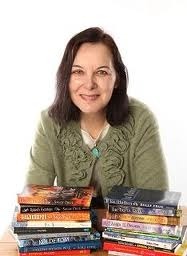 When Sally Prue's first novel, 'Cold Tom' won the Branford Boase Award and the Smarties Prize Silver Award in 2002, it was clear that a wonderful new writer of folklore-based fantasy had arrived. 'Cold Tom' taps into many legends and ballads about the fairies - the Tribe, which lives on the common. They are cold-hearted, dangerous, feral hunters, pitiless to those who, like Cold Tom himself, are different. And they see humans as demons: ugly lumpen beings, hopelessly tied and enslaved to one another by a tangle of emotional bonds like vines.
When Sally Prue's first novel, 'Cold Tom' won the Branford Boase Award and the Smarties Prize Silver Award in 2002, it was clear that a wonderful new writer of folklore-based fantasy had arrived. 'Cold Tom' taps into many legends and ballads about the fairies - the Tribe, which lives on the common. They are cold-hearted, dangerous, feral hunters, pitiless to those who, like Cold Tom himself, are different. And they see humans as demons: ugly lumpen beings, hopelessly tied and enslaved to one another by a tangle of emotional bonds like vines.It's a powerful and startling image, and one of those moments only fantasy provides: when we step right out of the human world and see it from outside, like seeing the Earth from space. Cold Tom is only half elfin. His fangs aren't growing, the Tribe rejects him, and the only place to run is the city of the demons. How on earth can he adjust to humanity and the ties that bind us?
Sally's writing reminds me of Diana Wynne Jones who wrote books of otherworldly beauty – I'm thinking of 'Power of Three' and 'The Spellcoats' – as well as more homely and amusing stories for younger readers, such as the Chrestomanci books. 'Cold Tom' and its recent sequel (or more accurately prequel) 'Ice Maiden' are YA reads: chilling, haunting, sharp-edged. Here young half-German Franz, who has fallen into a pit on the common while chasing the elfin Edrin, finds a heap of elfin bones, and prods the skull:
This time there was no doubt: the white bone moved. More than that, it gave way, swiftly, bewilderingly, and before he could stop it his finger had gone right through the bone into the brain cavity.
He snatched his hand back in horror, but somehow, horribly, the whole skull came with it. Panicking, he tried to bat the thing off with his other hand, but those fingers sank into the stickily melting bone of the skull, too.
And suddenly Franz's head was full of savage laughter, and glowing eyes, and dangerous darkness.
And singing.
Sally is also the author of a trilogy of books for younger, 'middle grade' readers: the Truth Sayer Trilogy. As Sally comments on her website: "You know how people are always going into a different world and then discovering that everyone speaks English? Well, what if they don't?"
I love this. Young Nian is taken away from his family by the Tarhun, warrior priests, to be trained as a seer and Truth Speaker at the House of Truth on the Holy Mountain. Nian may have great powers, but he misses his family and finds the stern House little better than a prison. So he tries to escape. This sounds like the stuff of many other fantasy novels, but Sally's sense of humour and strong characterisation distinguish Nian's erratic career across the universes, landing in our own world – Earth – in the bedroom of a very ordinary boy called Jacob. Neither can understand a word the other says, and comic mayhem follows. In a way, it's the same theme as the Cold Tom books: looking at our world from outside, seeing ourselves as others see us. The trilogy also encompasses a variety of thought-provoking ideas about the nature of time and space, and besides the comedy, there are some tremendous moments of imagination and terror: as in the second book of the trilogy, the March of the Owlmen, when the knife-sharp, two-dimensional Owlmen come slicing into the world.
So welcome to Sally Prue, who is going to talk about searching for fairyland and finding it (maybe) closer than you expected: in the mirror, out in the yard, around the back of the supermarket carpark. For as Franz thinks to himself at the beginning of 'Ice Maiden' – 'This wasn't a folk tale, this was 1939. There were no elves or fairies here, any more than there were wolves. It was impossible, completely impossible, there could be any kind of creature anywhere near him… And at this same moment something hit him violently in the back.'
THE ENCHANTED MIRROR
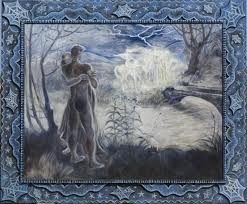
We didn't lack books in my childhood home. I mean, we had a Bible, a Be-Ro cookery book, David Copperfield, Shakespeare, and, oddly, the collected poems of Walter de la Mare.
Mind you, of these only the cookery book was ever actually opened.
But we had a large blue set of Arthur Mee's Children's Encyclopaedias, too. I think they must have been my father's. They were from the 1930s and extremely dull. Occasionally, though, the pages of dense text and murky photographs of the Queen Mary's turbines were enlivened by brief re-tellings of classic tales.
Now, I must be honest here. As a child I had no taste. What I wanted from a story was, first of all a HAPPY ENDING, and secondly REALLY NICE CLOTHES. Ideally that meant princesses, but even a goose girl would do as long as her rags were elegantly tattered and her apron strings were blown into delectable volutes.
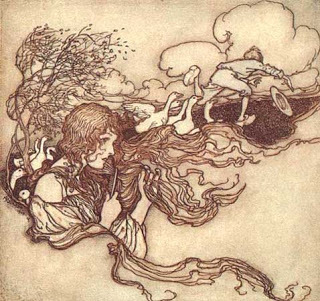
I very happily read all Arthur Mee had to say about Cinderella, Sleeping Beauty and The Ugly Duckling (a great favourite: I was the only girl in my class without fair hair and so I was constantly cast as the witch in our singing games. But oh, I thought, perhaps one day...).
Those were important stories. They introduced me to beauty in art. They taught me that the values of my family were not the values of the whole world. They taught me to hope.
For the time being, though, I was young, and therefore enslaved and helpless. To make matters worse the land of the princesses was plainly very far away. I knew of no real-life princesses except Princess Anne, and she seldom appeared swathed in acres of bouncing chiffon, which was surely the entire point of being a princess.
(Actually, Princess Anne never appeared in acres of bouncing chiffon. I just couldn't begin to understand it. Reefer jackets?)
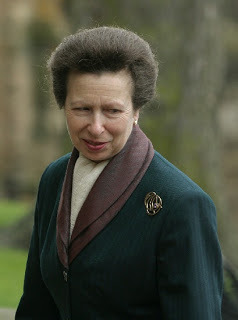
Now, unfortunately, Arthur Mee's stories were not very many, and not very long, and I soon began to suffer from serious princess-starvation. Looking back, I can see that in the man's world of the 1930s Arthur Mee had been generous to include any princesses at all. They were probably as unappealing to him as the Queen Mary's innards were to me. But there it was: all too soon a thoroughly satisfactory story like Snow White would be followed by something about Camelot or Olympus which were dull dull dull, with few happy endings and fewer princesses, and those there were dressed in either their nighties (Olympus) or their dressing gowns (Camelot).
I realise that so far I have proved myself to have been the dullest, least numinous sort of child (so lacking in genius that I was quite unable to make anything at all of David Copperfield, Shakespeare, or Walter de la Mare) but I'm sorry to say that things are about to get even worse, because for my seventh Christmas my Cousin Ann bought me a copy of Chimney Corner Stories by Enid Blyton.
Now, I don't think there are any princesses at all in Chimney Corner Stories, and Enid Blyton isn't really interested in clothes, either: there's one really shocking tale about a doll who cuts up her lace coat to make some curtains for a dolls house, an act of madness of which the author seems, astonishingly, to approve.
Still, Enid Blyton's stories are solidly constructed and I found them extremely satisfying. By far the most marvellous thing of all, though, was that in several of the stories the elves come out of fairyland into our own world. One elf gives wishes to ordinary children (and I was, as we have seen, a very ordinary child) and another (actually I think it might have been a goblin) is banished from fairyland for wickedly stealing hairs from caterpillars to make paint brushes.
Now that was truly astonishing, because it meant that fairyland couldn't far away at all. Those elves and gnomes were coming and going from fairyland to my world just as easily as I left home to go to school.
Think of that! Snow White's country was clearly a long way away (and once upon a time, as well) but these gnomes were emerging from their fairyland straight into contemporary England – a rather smug version of contemporary England which included servants and ponies, true, but recognisable for all that.
Not only that, but when I looked at the fairies' clothes (always the clothes!) I saw that some of them were wearing bellbine hats. Now, bellbine grows along municipal chain-link fencing everywhere in England. Why, bellbine even grew through the hedge between my house and the plastic bag factory!
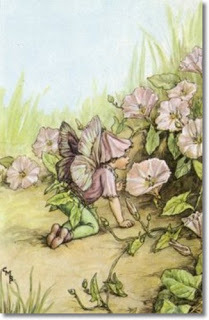
And if there were bellbine flowers, then perhaps...well, even Sir Arthur Conan Doyle (as I learned from the children's TV programme Blue Peter) had believed there might be fairies at the bottom of the garden.
I searched and searched among the bellbine, and occasionally I saw something, or just missed seeing something, or heard a mysterious rustling, which might have been a fairy. It was enough to keep my new hopes alive.
When I got to the junior school I had access to more books, and my horizons widened accordingly. I learned about the wardrobe, of course (my parents' wardrobe contained not one single fur coat and perhaps that was why it proved a continuing disappointment) and later, I suppose by this time at secondary school, I learned about Herne the Hunter in Windsor Great Park, and the god (or goddess) Sul who lives in the hot spring at Bath.
I learned about a very local haunting, Harcourt's Chariot, which rattles precipitously down the Back Hollow from Ashridge to Aldbury.
I learned about the Romans' lares and penates which guard boundaries and households. I found out about the green men who have been hiding in the foliage around us for so long that no-one knows any longer where they came from or why they are watching us.
This intrusion of otherworldly beings into my own England was startlingly different from the stories of Camelot and Olympus, and different from the stories of the princesses, too. Herne and Harcourt and the green men were here, now, close as breathing, casting shadows on my back. Mount Olympus might be a real place, but it was far beyond my reach (I'm sorry to say that the furthest we'd ever gone on a family holiday was Lyme Regis).
In any case, to visit the Olympians you needed Hermes' wings, or Iris's rainbow: there was no way, even in my wildest fantasies, I was going to find Apollo mooching about round the back of a plastic bag factory. (I admit that nymphs seemed to get about a bit, but nymphs were like Star Trek security men: shallow in character and soon dead.)
I was realistic enough to know, anyway, that even if I could get to Olympus or glum Camelot then none of those grand people – Lancelot or Zeus or Morgan Le Fay or Hera – was going to be the slightest bit interested in me. (If Adele Geras's marvellous stories of the Greek gods had been available I might have felt differently about this, but, alas, they were yet to be written.)
So that left me with Herne the Hunter and various ghosts, pixies and green men – none of them, frankly, either snoggable or the sort of people you could take home to meet your parents. My interest in fairyland wobbled.
But then one day a boyfriend said do you like folk music? and put on a record. It was a song about a real place, Carterhaugh, where it is so easy to pass from England to fairyland that the tale begins with a warning:
Oh I forbid you, maidens a' That wear gowd in your hair, To come or gae by Carterhaugh For young Tam-lin is there.
Tam-lin. And suddenly there it was, opening before me: a handsome prince grown close and dangerous, stepping out of the pages of a book and onto the real earth of my own country. Janet has kilted her green kirtle A little aboon her knee... And she's awa to Carterhaugh As fast as she can hie.
And who, frankly, can blame her?
Oh yes, and suddenly the roots of fairyland were growing out and penetrating into real life again, into my life, for Janet is no beflounced princess, but a woman of warm blood and hot desire who knows what she wants and is prepared to fight to get it.
Yes. I discovered I was now old enough to journey far – and fight for what I wanted, too.
Fairyland had grown, just as I had, and yet again, like an enchanted mirror, it was showing me not my own reflection but my heart's desire. Over the years it had presented to me visions of beauty, hope, escape, romance, and in the end courage.
And I'll tell you something. That boyfriend never got away.
Picture credits:
Sally Prue
Tam Lin copyright Dan Dutton
Princess Anne in The Courier
The Convulvulous Fairy by Cicely Mary Barker
Published on July 29, 2011 01:38
July 21, 2011
Fairytale Reflections (28) Lily Hyde
 Lily and I haven't actually met yet, although I hope one day we will. It'd be tricky to arrange right now, as she's been on the road for over a year. She's travelled through Russia, the Ukraine and the Crimea: I think she was in China when we first began to talk online; and she's currently in Tibet. I'd come across her marvellous travel blog 'This Trolleybus is Going East', but hadn't got around to reading her books, although they sounded right up my street. We discovered we had a number of favourite books in common – Ann Lawrence's 'The Hawk of May' for one – and this is always a good omen. So I felt eager to read one of her own books even before she sent me this irresistable email:
Lily and I haven't actually met yet, although I hope one day we will. It'd be tricky to arrange right now, as she's been on the road for over a year. She's travelled through Russia, the Ukraine and the Crimea: I think she was in China when we first began to talk online; and she's currently in Tibet. I'd come across her marvellous travel blog 'This Trolleybus is Going East', but hadn't got around to reading her books, although they sounded right up my street. We discovered we had a number of favourite books in common – Ann Lawrence's 'The Hawk of May' for one – and this is always a good omen. So I felt eager to read one of her own books even before she sent me this irresistable email:I have to tell you this – I'm in Tagong, which is a tiny town high in the grasslands on the edge of the Tibetan plateau, full of monasteries and prayer flags and yaks and swaggering cowboys holding hands, wearing Stetsons, and with silver and coral rings in their black plaits… and in the hostel where I'm staying I found a copy of 'Troll Fell'!
I thought you'd like to know how far your words have travelled (further away from the sea than the Vikings ever got?)
Well of course I was thrilled and delighted. 'Go, little book...' (And it made me wonder what might be the record for the furthest-flung sighting of an author's book? I intend to claim the title until someone can trump this!)
Lily's first book, 'Riding Icarus', is the enchanting story of Masha, who lives with her grandmother in an abandoned trolley-bus (called Icarus), 'on the very edge of Kiev, by the Dnieper River. With no overhead electric wires to fix onto, the two long springy rods attached to the roof waved in the air like antennae, forever searching for a new source of power on which to drive away.'
Masha's father went away to Kamchatka four years ago, and then Igor, her mother's 'friend', appears:
Igor, who told Masha to call him uncle even though he wasn't, and who had found Mama a job abroad where she could earn lots of money. So Mama had gone to Turkey, leaving Masha with Granny.
But the money doesn't come, and Mama doesn't come back, and Masha and Granny have nowhere to live except the trolleybus. Then, on the night of Masha's tenth birthday, there is a terrific thunderstorm
[A] huge roar came… it was the thunder; it was the pain of broken bones; it went on for ever. She could see her grandmother shouting at her, but she could hear nothing. …Granny seized her arm and began pulling her towards the doorway.
Masha pulled the other way. Granny must be mad, taking her outside! She'd be blinded, …deafened, trampled by the huge paws of the storm. They struggled in the open doorway, yelling at each other and hearing nothing, while the world went once more dazzlingly white.
Then Icarus moved. A sudden, violent lurch forward. Granny tumbled off the step outside, and Masha fell inside. And Icarus, antennae suddenly straining onto an invisible, humming wire, drove away into the storm.
The story, while rooted firmly in modern Kiev, develops into a tale of magical midsummer wishes, your heart's desire, dancing Cossacks, mystical tigers, the power of love and friendship, and an exceedingly nasty and all-too-believable villain. Lily Hyde writes with a sure but delicate touch, and the serious theme of people-trafficking is clearly hinted at without ever becoming too heavy for younger readers. I'm looking forward very much to reading her second novel, 'Dreamland'.
There can be something oddly meaningful about finding homeless English books abroad (I found my precious copy of Thomas Keightley's Fairy Mythology at a church book sale in Fontainebleau, and it provided the material I needed to write my first book, 'Troll Blood') and it looks as though Lily has good luck this way too. Which is why her Fairytale Reflection is not about a Russian or Chinese or Tibetan tale, but a Welsh one:
The Lady of Llyn y Fan Fach
For nearly a year now I've been on the road. I've spent most of my adult life in other countries than the one I was born in. I've been reading and writing fairy tales for as long as I can remember.
Sometimes I blame fairytales for my longing to travel and encounter unknown people and places. Many fairytales involve journeys: across mountains of glass, forests of thorns, the seven miles of steel thistles of this blog's title. And of course the tales themselves travel; versions of 'Cupid and Psyche' appearing in Scandinavia, Japan…
Even more stories involve a meeting between the ordinary and the unknown; indeed, isn't that where their name comes from – fairy or faerie, that other realm that is so like our own but so utterly different. Some of my most-loved fairytales, the ones that have worked their way into my life and writing, are about encountering the new and strange, and falling hopelessly in love with it.
I don't know where I first read or heard 'The Lady of Llyn y Fan Fach'. It seems I've always known the story. But I came across it again on a neglected bookshelf in Kiev, in a book of folk tales from the British Isles bizarrely published – transcribed regional accents and all – in the Soviet Union.
I seized on this book like a piece of home. I was sharing my life with a man from a different country, a stranger in his strange land. Sometimes I felt like I was living in a fairytale. I felt like the lady of Llyn y Fan Fach.
In this Welsh tale, a shepherd by the lake in the Black Mountains sees a beautiful woman appear on the water, and falls in love. He woos her with his lunch, bread his mother baked, and finally wins her on the third try with bread that is neither over- nor under-cooked. The lady – fairy or goddess or just a stranger from a strange land, we are never told – agrees to live with the man until he strike her 'Tri ergyd diachos' – three causeless blows.
What happens next is a paradigm of a marriage.
The first time, they are late for a christening and the lady says she will fetch the horse to ride there if her husband brings her gloves. But when he comes back with the gloves she hasn't brought the horse, and he strikes her.
The second time, the shepherd strikes her at a wedding after she starts weeping loudly "because these people are entering into trouble".
The third time she begins to laugh uncontrollably at a funeral, because, she says, death puts people out of their pain. And he strikes her.
'She then went out of the house saying, "The last blow has been struck, our marriage contract is broken and at an end. Farewell!"'
For me this story is about the encounter with the unknown, its fascination and its incommensurability. Maybe the lady knows the marriage will end in unhappiness – usually in fairytales when someone is told not to do something or else, you know they're going to do it. But she marries the shepherd anyway. Maybe she is as charmed by his difference as he is enchanted by hers; the story doesn't tell.
Yet the lady's differences from her husband are not really between fairy and mortal. They're the yawning gaps in understanding between two people.
The first time is a classic scene of family frayed tempers. The annoyed husband strikes her gently enough (it's always emphasised that his blows are gentle) because she broke a promise and lied to him, however frivolously; suddenly she is not what she seems.
The second time, he must be baffled and embarrassed by her strange behaviour at the wedding – and maybe wondering what she is trying to say about their marriage.
The third time, at a funeral, he is surely shocked by the apparent heartlessness and bad manners of this person he can't understand.
How can you ever causelessly strike the one you love? But the moment comes, the gap opening at your feet as you realise this person you love and think you know is a stranger; a liar, a laugher at funerals and a weeper at weddings, someone you simply do not know. You teeter on the brink of the pit; that's when you lash out.
There is a lovely, wise, updated Joan Aiken version of the Welsh story, called 'The People in the Castle'. The anti-social village doctor falls in love with the lady's silence and mystery, and is disappointed when after moving in with him she turns out to be a sociable, movie-loving chatterbox. It's as if he's married a swan, only to find out she is just a girl in a feather dress.
That brings me to those stories in which people marry beings who are literally not what they seem: the white bear who is actually a prince; the frog who is Vassilisa the wise and clever under a spell – stories that retell 'Cupid and Psyche'.
Very often it's glimpsing this truth sooner than they should, through curiosity, impatience or embarrassment (everyone thinks I'm married to a frog/a bear/something I can't even see – the humiliation!), that parts couples and sends the heroines or heroes off on their travels across glass mountains and forest of thorns to bring their beloved, in his or her true form, back home.
Those are the optimistic stories.
The pessimistic version is that harsh lesson in not knowing and curiosity, 'Bluebeard's Castle', in which the wife discovers her husband is hiding the dead bodies of his previous wives. A more mixed (and gender-reversed) Russian version tells of Queen Marya Morieva and her husband Ivan, who however much he loves her can't resist opening the forbidden cellar door. Out comes Koschei Deathless to chop Ivan into pieces ("Let him chop!" says Ivan recklessly, "for if I can't live with you, Marya Morieva, I would rather not live at all.")
"If you had only waited and not peeked," reproach these secretive lovers who are not what they seem. "If you had only listened to me and not opened the door." A trust has been broken, and hardship and separation ensues.
In many stories, the love, courage and ingenuity of the heroes or heroines ensures reunion, and a traditional Happy Ever After. Through these journeys to find their lovers (or more rarely siblings or parents), people discover themselves; no longer passive partners being married off or carried off, but actively seeking happiness.
Other stories suggest that the whole of another person is, in the end, impossible to grasp. And if we can't accept the ultimate unknowability of the one we love, then we are destined to live forever apart. Like the Gaelic seal bride, who always finds her seal skin however the husband hides it, and goes back to her unknowable life in the sea. Like the Japanese Sea King's daughter in the tale 'The Sea King and The Tide Jewels', who leaves forever when her husband discovers her true, truly other form is that of a dragon.
Joan Aiken takes pity on her Welsh doctor, and has the mysterious lady return to him one night. The Lady of Llyn y Fan Fach never comes back. She does show herself to her sons though and teaches them medicine, thus rooting the tale in historical reality since these sons established a line of famous Welsh physicians that continued till the 18th century.
I won't tell you the end of my own story with a beloved from a different land. But it's only in writing this reflection that I've realised one of my novels, a sequel to Riding Icarus, tells just this kind of fairytale journey.
The heroine, Masha, runs away from her mother, who is traumatised from an unwilling journey into the realities of trafficking, and sets off on her own journey across Siberia to Kamchatka and her absent father. There Masha meets a rat who is really a boy; she discovers her father is not what he seems – or what she wants him to be. In the end she realises the purpose of her journey wasn't what she thought at all; really it is the true form of her mother she was trying to find and to rescue all the time. Her mother as a complicated, vulnerable person in her own right; someone Masha has to get to know just as in turn her mother has to get to know her, while both accepting there are things they will never truly understand about each other.
My editors thought the ending of this book wasn't Happy Ever After enough for its intended young adult audience.
But where is the real fairytale, the happy magic, in a story like 'The Lady of Llyn y Fan Fach?'
Maybe in this: we can never truly know, but despite and because and anyway, how much we can love…
Published on July 21, 2011 23:59
July 15, 2011
Fairytale Reflections (27) Joanne Harris
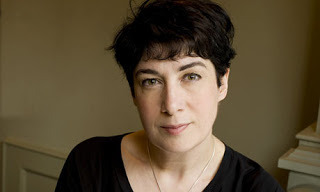 My guest this morning needs no introduction. And I'm really delighted to welcome Joanne Harris to Fairytale Reflections. As anyone who's read them knows, Joanne's adult books are certainly not fantasies – but they aren't exactly straightforward cold-light-of-day realistic novels either. They contain elements of magical realism, along with many fairytale references.
My guest this morning needs no introduction. And I'm really delighted to welcome Joanne Harris to Fairytale Reflections. As anyone who's read them knows, Joanne's adult books are certainly not fantasies – but they aren't exactly straightforward cold-light-of-day realistic novels either. They contain elements of magical realism, along with many fairytale references.Joanne seems to be a writer who is comfortable with the superstitious, supernatural side of human life. Bottles of homebrewed wine in 'Blackberry Wine' actually narrate parts of thestory. The chocolate in 'Chocolat' is almost sacramental food. Joanne's characters are open to all kinds of magical or spiritual influences. They see ghosts, they consult the tarot, they dance with shadows.
Her children's book 'Runemarks' is a wonderful concoction of Norse legend and fantasy. Not every adult writer who tries their hand at children's fiction is always entirely successful: some seem a little stiff or self-consciously playful. Joanne's book just grabs you from the marvellous opening sentence:
Seven o'clock on a Monday morning, five hundred years after the End of the World, and goblins had been at the cellar again.
And it's not long before the brave and independent heroine, Maddy Smith, born with a runemark (or ruinmark) on her hand, is off exploring the labryrinthine caverns under Red Horse Hill with a goblin guide, hunting for the mysterious 'Whisperer' at the instigation of her old and ambiguous mentor, One-Eye. A magnificent adventure follows.
Vianne and her daughter Anouk in 'Chocolat' blow into the little French town of Lasquenet-sous-Tannes 'on the wind of the carnival' very like Mary Poppins blowing into Cherry Tree Lane on the East Wind: and Vianne proceeds to sort out the lives and problems of the inhabitants just as Mary Poppins sorts out the dysfunctional Banks family. I hope no one thinks this is a whimsical comparison. P.L. Travers' Mary Poppins books (as against the Disney version) have always carried an undercurrent of something deeper: the anxiety of the children that Mary Poppins should stay with them forever, and the impossibility of it - along with, I think, more than a little social criticism of a system which handed children into the care of nannies whom they loved and lost.
She paused for a moment on the step and glanced back towards the front door. Then with a quick movement she opened the umbrella, though it was not raining, and thrust it over her head.
The wind, with a wild cry, slipped under the umbrella, pressing it upwards … it lifted Mary Poppins from the ground …over the front gate and swept her upwards towards the branches of the cherry trees in the Lane.
"She's going, Jane, she's going!" cried Michael, weeping.
[Mary Poppins, P L Travers, 1934]
And as Mary Poppins can promise to stay only 'till the wind changes', so 'Chocolat' ends with Vianne almost staying – wishing to stay –
I could stay here, Maman. We have a home, friends. The weathervane outside my window turns, turns. Imagine hearing it every week, every year, every season.
But the bitter-sweet ending suggests she won't stay. Instead she sings the haunting little lullaby to her daughter:
V'la l'bon vent, v'la le joli vent V'la l'bon vent, ma mie m'appelle.
Hoping that this time it will remain a lullaby. That this time the wind will not hear. That this time – please, just this once – it will leave without us.
'Chocolat' is full of other magical references too. Vianne's chocolaterie is a veritable Gingerbread House – there is even one in the window – and she is described by several characters as a witch. Her window display lures in the good citizens of Lasquenet; but instead of destroying, Vianne's chocolate cauldron restores: rebuilding the relationship between the boy Luc and his grandmother Armande, for example.
The connection between food and magical power – for what can be more powerful than the offer of nourriture, nourishment? – is emphasised in another passage from 'Chocolat', when Vianne changes her window display for another even more strongly suggestive fairytale. She builds a mountain of green tins covered in crinkly cellophane to represent ice, with a river of blue silk and a cluster of houseboats:
And below a procession of chocolate figures: cats, dogs, rabbits… and mice. On every available surface, mice. Running up the sides of the hill, nestling in corners, even on the riverboats. Pink and white sugar coconut mice, chocolate mice of all colours, variegated mice marbled through with truffle and maraschino cream, delicately tinted mice, sugar-dappled frosted mice. And standing above them, the Pied Piper resplendent in his red and yellow, a barley-sugar flute in one hand, his hat in the other.
… I cannot help myself; the window is inviting enough, but I cannot resist the temptation to gild it a little, closing my eyes, to light the whole with a golden glow of welcome. An imaginary sign which flashes like a beacon – COME TO ME. I want to give, to make people happy: surely that can do no harm.
But Vianne's helpful actions arouse opposition and hostility. And now I'll shut up and allow Joanne Harris herself to step forward and tell you all about
THE PIED PIPER OF HAMELIN
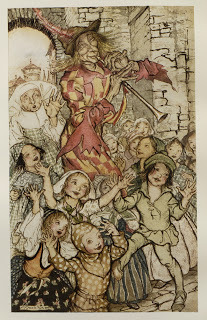
Raised as I was on the darkest, grimmest of Grimm's fairy tales, I've always been very much aware of the dual nature of the world depicted in folklore and story. For every happy ending, there is an equally tragic one; children left to die in the woods; lovers parted forever; villains with their eyes pecked out by crows, or burnt alive; or hanged. Fairytale is a world away from the comfortable assurances of the Disney franchise – and surely that was the purpose of those original fairy tales, devised as they were for an audience comprising mostly of adults; often very poor; people whose lives were cruel and harsh, and who would never – even in fiction - have accepted to believe in a world in which the shadows did not at least occasionally rival the light.
My favourite of these ambiguous tales was always the Pied Piper. It's interesting that this very well-known story has never been softened and sweetened in the way in which, for instance, The Little Mermaid, or Sleeping Beauty, or Cinderella have been adapted to suit our more sensitive times and cultures. Perhaps because the main character is such a sinister figure, nameless, appearing from nowhere, then vanishing into nowhere again, leaving nothing but unanswered questions and a story that lingers uncomfortably without a happy ending. But the ambiguity and the unanswered questions are part of my fondness for this tale, which seems to me to sum up perfectly our uncomfortable relationship with the world of magic and story, a relationship that combines longing and fear in fairly equal proportions.
Like all stories carried down through the oral tradition, there are many versions of the Pied Piper. Mine goes like this.
Once, the town of Hamelin was overrun by a plague of rats. (One of this story's most interesting characteristics is that it is set in a real place, thereby locating the action somewhere between the conscious and the unconscious mind.) The rats were huge, black rats, and they spread like wildfire through the town, invading store-rooms and cellars, getting fat on grain stores, finally growing so big and so bold that they would snatch food right off dining-room tables, or little children right out of their cribs. (At this point, I remember an illustration in one of my grandfather's old books, which showed a nurse looking into a crib, frozen with horror at the sight of a big rat sitting there in place of the baby.) No-one in Hamelin knew what to do. The Mayor, faced with a crisis such as he had never seen, announced a reward of a thousand crowns to the man who could rid the town of the rats.
The next day a stranger came into town. (It's worth noting here how often the very best stories begin with the arrival of a stranger into a closed community.) He was a beggar, by the look of him, with red hair and a jacket of two colours. (This is what made him the Pied Piper, and I spent a long time as a child trying to determine exactly what this pied quality meant in visual terms. Some books depicted him in yellow and red, like a court jester. Some said he was in red and green, a combination sometimes associated with the fairy world. I imagined him as a magpie; white on one side and black on the other, with the added associations both of bad luck and theft.) The man had no horse, no money and no possessions but a set of reed-pipes, on which he played very beautifully. (I also spent a very long time thinking about those pipes of his. I'd first read the story in French, for which the name of the instrument was "flûte." In English, however, the stranger is described as a "piper," which to me implied either bagpipes – which seemed unlikely - or maybe some kind of recorder, also referred to as "flûte", or "pipeau" in French. I finally decided that the stranger played the pan-pipes, an instrument that has long been associated with the primal, darker side of Nature. This may seem like a trivial point, but in these old stories so many things are lost in translation – look at Cinderella's glass slipper – that it's sometimes worth checking the details.)
The Pied Piper had seen the rats and knew of the Mayor's pronouncement. "I'll rid you of your plague," he said. "But remember, you promised to pay me."
The Mayor, who, like all politicians, was more concerned with making promises than with keeping them, and besides, had little confidence in a man who couldn't even decide on a single colour for his coat, agreed, rather too eagerly.
And so the Pied Piper took out his pipes and began to play a very simple little tune.
No-one could quite remember the notes of the tune the piper played (this should have come as a warning,) but it was a warm and lilting tune, bright and wistful at the same time; the kind of tune that makes people smile almost without knowing it, the kind of tune that makes folk tap their feet and think about dancing. And as the Piper played, the rats came out of the cellars to listen to him; and they slunk out of the back alleys and the grain-stores and sewers and ditches, and went off in the wake of the Piper, who ignored them and just went on playing that very simple little song, making his way quite casually into the centre of Hamelin, where the river ran fast and deep. And when he got to the river, the Pied Piper stood on the quay and played a little faster, and all the rats that had followed him ran straight into the river and drowned; and that was the end of the plague of rats.
The next day the Piper went to the Mayor to collect his thousand crowns. (One of the beauties of this tale is its continuing relevance. Centuries down the line, and artists – musicians and writers - are still fighting to be paid for the work they do, while people like the greedy Mayor still believe they can get it for free.) But the Mayor just laughed at the Piper, and said; "A thousand crowns for a tune? You must be out of your tiny mind. I'll pay you a shilling for your trouble, and I'll not ask to see your performer's license."
The Pied Piper wasn't amused. (I've always seen him as red-haired, and red-haired men have a temper.) His mouth grew tight, and his strange green eyes narrowed, and he turned to the people of Hamelin and said; "You all heard what he promised me. You can make him keep his word."
But the people of Hamelin knew perfectly well that the thousand crowns, if they were paid, would come straight out of their taxes. And now that they were free of the rats, it rankled to pay such a large sum to a man who had done nothing more than blow into a handful of reeds.
The man was a vagrant, after all; probably an illegal too. Why should their hard-earned taxes go to an undesirable? And so they said nothing, and shuffled their feet, and the Pied Piper got angry.
At which point the Mayor, who had been waiting for the chance to pin something on the vagrant, had the Piper thrown out of town, with orders never to return. But as he reached the town gates, the stranger took out his reed pipe and once again began to play. No-one paid much attention at first. After all, the rats were gone. But the children of Hamelin heard the tune – a music that was at the same time wild and a little wistful, merry and unutterably sad – and they came out to hear the Piper. Heedless of parents and teachers alike, children all over Hamelin left their games and their schoolwork, abandoned their bicycles in the street, left football matches and skipping-ropes and went dancing off in the Piper's wake. (I like to think that the tune he played was something only children could hear; a sound beyond the normal frequencies of the adult register. Perhaps it was; or perhaps children are just more susceptible to the call of the subconscious mind.)
They followed the Piper out of the town until they came to a round hill; and as they approached, a secret door inside the hill swung open, revealing a dark passage beneath. (I was born in a coal-mining town and in the waste ground behind my house there were several abandoned mineshafts. As a child I was at the same time terrified and fascinated by these, and spent hours crawling around the entrances to various tunnels and openings, certain that sooner or later I was going to get into Fairyland. Like the little lame boy, I've been looking ever since.)
One by one, the children followed the Piper into the hill –and then the door to the passage slammed shut and none of the children were ever seen again. Only one child was left behind – a lame boy, unable to keep the pace, who was still outside when the hill closed.
As for the Pied Piper, whoever he was, no-one ever saw him again either, although some people thought they heard music coming from under the hill – music, and children's voices, though whether the children were laughing or screaming, no-one could ever be certain.
As for the Piper, whoever he was… Perhaps this is the real reason why Disney has no use for this tale. There is no comfortable conclusion to this story; no happy-ever-after, not even a clear explanation. What happened to the children? Did they die inside the hill? Did the Piper abandon them there? Or were they (as I liked to believe) taken to another world, where children never have to grow up, forever free of the hypocrisy, greed and meanness of adult life? And who is the Pied Piper? The King of Faërie? An agent of Death? A parent's worst nightmare? A child's fondest dream? What happened to the lame boy? Did he spend the rest of his life trying to find the secret door, or did he have a lucky escape? I've always thought that a good story should ask at least as many questions as it answers, and this one seems to me to be a perfect example of the genre.
Yes, and it is a fairy tale. In recent decades it seems to have become fashionable to look down upon the fairy tale and to value instead the kind of reading matter that deals with "serious issues". In short, we have learnt to look for answers, rather than questions in the stories that we read. Surely this is the opposite of what a story should do for us. One of the reasons fairy tales and legends still resonate so strongly with us is that in spite of their apparent irrelevance to the topical problems of the "real" world (one of my grandfather's sternest criticisms was to refer to something as "airy-fairy", which implied both lacking in substance as well as dangerously imaginative), they nevertheless manage to locate our most sensitive pressure points, those things that transcend mere topicality, heading straight for the collective unconscious. (If you need further proof of this, try naming ten classic fairy tales from memory. Then try naming ten Booker prize-winners. See which ones you remember best.)
Lastly, for me, the Pied Piper is the perfect metaphor for our relationship with stories and storytellers. We all enjoy stories, but we also mistrust the subconscious world from which they spring, and we are often ambivalent, dismissive, fearful or sometimes downright ungrateful towards the people who create them. The Piper, like all artists, exists outside of society; his morality (such as it is) is fundamentally different from ours; he can be helpful or malevolent according to whim and his personal code; and his world, though appealing in many ways, is fraught with danger and mystery. As children, we often identify with the child characters in our stories. As an adult (and as a writer, of course) I have come to identify increasingly with the Pied Piper. Poised uncomfortably between the real world and the world of magic, keeping his audience in thrall; making them believe in things that they know to be impossible; facing both love and hostility with nothing more than a handful of tunes (or a story) between himself and the darkness - isn't that what we all do? In a world that claims no longer to believe in magic or fairies or monsters, magic is still a powerful force, existing beneath the surface of things, ready to emerge when summoned by just the right combination of musical notes or of words on a page –
A story can bring down a government; or steal away a child's heart; or build a religion; or just make us see the world differently. Storytellers come and go, but stories never die. And if that isn't magic, then I don't know what is.
Published on July 15, 2011 00:12
July 8, 2011
Fairytale Reflections (26) Pauline Fisk
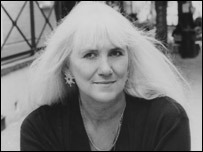 Pauline Fisk is a fantasy writer of rare talent. Her books take you where few writers even think to go, interweaving strands of the real world with airy fibres so fine and strong, they are barely even fantasy – more like mysticism, or elemental forces. She writes about vast emotional themes of love, anger, insecurity, and the need to belong to people and a place. They leave a lasting imprint on the mind.
Pauline Fisk is a fantasy writer of rare talent. Her books take you where few writers even think to go, interweaving strands of the real world with airy fibres so fine and strong, they are barely even fantasy – more like mysticism, or elemental forces. She writes about vast emotional themes of love, anger, insecurity, and the need to belong to people and a place. They leave a lasting imprint on the mind.Her first book, 'Midnight Blue', which won the Smarties Book Prize in 1990, is a story about a young girl called Bonnie who has just found a home with her very young mother, in an inner city block of flats. Just as it looks as if they can be happy together and build their relationship, her controlling, rigid and malevolent grandmother moves in: and Bonnie runs away, finding refuge in a mid-city oasis, a walled garden in which a mysterious man called Michael is building a hot air balloon with the help of a strange shadowy boy. Michael's aim is to fly to the land beyond the sky:
Beyond the sky. Not 'in outer space' or 'in another galaxy', but beyond the sky… as though it were possible to peel away the edge of the blue and pass straight through.
Bonnie and the shadow-boy seize the balloon and fly without him.
As they rose, the sun rose with them, as if they were racing for the top of the sky. Its warmth welcomed them, turned the dark skin of the fiery balloon as Michael had named it, midnight blue. They flew straight up … the sweet, clear music of the lonely pipe, the only sound left in the whole world, drew them on until they prepared to hit the very roof-top of the sky itself. Then the smooth sky puckered into cloth-of-blue and drew aside for them, like curtains parting.
How on earth to follow that? Well, Bonnie wakes up, apparently after the balloon has crash-landed, in the bedroom of a farmhouse in a place called Highholly Hill, in the welcoming midst of a warm-hearted, but surprisingly incurious family whose daughter, Arabella, is almost Bonnie's doppelganger: herself as she might have been in a different, secure life. Far from relaxing into this idyllic world, Bonnie struggles with jealousy of Arabella, and hatred. And then her grandmother reappears, a sinister, knowing figure with the power to suck away the essence of a person and leave a simulacrum behind. There's a lot going on in this book.
(If you want to see Highholly Hill, look at the photo at the head of this blog. Pauline and I share a love for the magnificent and brooding hill called Stiperstones, in her home county of Shropshire on the Welsh border. In my book 'Dark Angels', I call it 'Devil's Edge'.)
Pauline has written many more books since then, and many of them are set in or around Shropshire and the borders of Wales. 'Sabrina Fludde', Bloomsbury 2001, opens with a body floating down the River Severn, the body of a lost, almost drowned girl whose memory is lost too, who plucks the strange name Abren out of the air for herself... In fact, the book is full of lost characters with strange names – a homeless boy called Phaze II; a speechless and motionless old woman called Sabrina Fludde. In the end, Abren has to return to her own source (and that of the river) on the mountain Plynlimon, where a cold and sinister family who claim her as their own. Alone and in terrible danger, she must make her escape down to the sea.
Abren listened to the stream murmuring as it flowed into the darkness. She fancied that she heard something. A snatch of a new sound carried on the water. Just a whisper, but growing all the time – and Abren knew what it was!
"You're fine," the stream sang sweetly. "Really. Fine. You're brave and strong and where you should be. There's nothing to be frightened of. Trust me."
Like 'Midnight Blue', the book is interwoven with legends and folklore. It's a gripping and eerie mystery with strongly realised modern settings, which looks at the way old hatreds tend to morph into new rivalries. When a gang of boys calling themselves the Border Commandoes push Abren off the iron bridge into the river, Phaze II is a shamed and unwilling witness:
Even when he saw the body, Phaze II knew he wouldn't do a thing. There it was right under him, waves breaking over it. And he knew he couldn't help. Not with the river in full flood. Not in the dark, with the water as cold as ice, and waves with jagged edges like hungry white teeth. "I can't!" he shouted, peeling out of his coat. "I won't!" he shouted, pulling off his boots. "NEVER IN A MILLION YEARS!" he shouted – and he jumped.
Do read these books, they are beautiful, and finely written, and completely unlike anyone else's. (Probably only Pauline could write about a girl who is, in some mystical sense, also a river). And now I'm going to let her tell you all about one of the most enduring legends of Shropshire…
WILD EDRIC (and me)
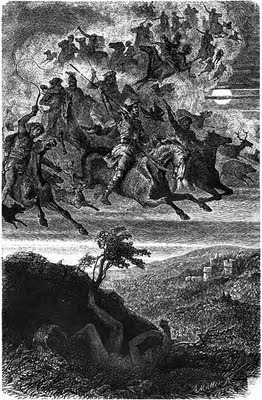
My whole life has been spent trying to bring together 'real life' and the world of fantasy, in particular by finding new and interesting ways of expressing a sense of the magical in my writing. Ever since I was five years old, hunting down fairies in the back alley behind my parents' house, a sense of more to life than meets the eye has been part of who I am. When I was a child, life was one big fairy tale. That was how I felt. But how to get into that fairy tale? How to make that fairy tale my life, and make it real and be a part of it?
It was through stories that I found the way. I couldn't write when I was five years old, but I could make up stories and that was what I did, standing at the garden fence, telling them out loud to the big children in the house next door, lined up on their side of the fence asking, 'What happened next?' But those stories, made up off the top of my head, were ephemeral. They were fly-by-nights, whereas words on paper had a strange new durability which I discovered when I learnt to write. Describing Winnie the Pooh hunting honey made me part of the story. Adventuring with the Famous Five turned them into a Famous Six. I made those things my own, and I made them real - and simply by writing about them.
This is something I've been doing ever since. When, at the end of 'Mad Dog Moonlight', I wrote about a river flowing through the stars, I put myself onto that river and sailed away. When Abren in 'Sabrina Fludde' turned to water and flowed down a mountain, I flowed too. And when hoof-prints beat upon the hill behind my house, I knew that Wild Edric, himself - that glorious superhero of Shropshire legend - was passing in the night. By writing him into 'Midnight Blue', I wasn't just making him up. The act of writing brought him to life.
Tolkien defines fairy tales as stories about the adventures of humankind in Faerie, and here amongst the hills, valleys, woods and towns of my home county, Shropshire, Faerie's all around me. It's where I live. It's a fabled place. And I'm twice blessed, because it also exists inside my head.
The power of imagination is the land called Faerie. 'We may put a deadly green upon a man's face and produce horror. We may make the rare and terrible blue moon to shine, or we may cause woods to spring with silver leaves and rams to wear fleeces of gold. In such 'fantasy' as it is called, new form is made; Faerie begins, Man becomes a sub-creator.'
Tolkien again, who wrote fairy tales for adults to read as a natural branch of literature rather than playing at 'being children', or pretending to enjoy them for the sake of the kids. 'When we can take green from grass, blue from leaves and red from blood, we have already an enchanter's power,' he wrote. And what else compares to having that power?
As a child I was captivated by Hans Christian Anderson's Fairy Tales. As a teenager I discovered Alan Garner's 'Weirdstone of Brisingamen'. Starting out in life as a writer myself, I fell head-first into Tolkien, and took some extracting. Finally I found my own voice and my own way into Faerie. This was a long process, which is what the word 'finally' is all about. For many years I thought that if I sounded like the writers I admired, Emily Bronte, Dylan Thomas, JRR Tolkien, Graham Greene – whoever the favourite of the moment might be – then I'd be a 'proper' writer but, if I sounded like myself, nobody would ever read me. A book of terrible short stories was published at the age of twenty-three [long since out of print, thank God], its lofty style definitely not mine. It wasn't until years later, embarking upon 'Midnight Blue' that I developed the confidence as a writer to be myself.
I'm indebted to that decision. 'Midnight Blue' would never have been written without it. But it also would never have been written without Charlotte Burne, the first woman president of the Folklore Society, whose 'Shropshire Folk-Lore: A Sheaf of Gleanings' introduced me to Wild Edric, whose mysterious presence haunts 'Midnight Blue'.
According to legend, whenever England is in danger, Wild Edric and his knights rise up from their sleep of centuries beneath a rugged range of Shropshire hills called the Stiperstones, and ride out in warning of impending doom. Charlotte Burne recorded conversations with people who claimed he'd been heard and seen before both the Battle of Waterloo and the First World War.
The history behind the story, as recorded in the Anglo-Saxon Chronicles, tells of a local lord who, having refused to submit to the Norman Conquest by raising a rebellion which was decisively defeated, betrayed his people by joining forces with the Conqueror. For this dastardly about-face, 'Wild Edric', as he became known, was doomed to sleep beneath the Stiperstones with his knights, only ever finding the release of death when England returned to her rightful people. He sleeps still, and some legends have added the comfort of a fairy wife, the Lady Godda, though others have him meeting and losing her before his days of betrayal and doom.
Wild Edric's is a great story and, both as legend and history, he's alive and well in Shropshire. After writing him into 'Midnight Blue', I attended a history society meeting where local Stiperstones people claimed to have heard him riding by, and one person even claimed direct descent. And he's alive and well in my life too. Later this year I'll be talking about him at a weekend I'm running on myths and legends and how to use them in creative writing. I'll even lead a walk up to the Devil's Chair, where he and his knights are meant to burst out of the ground.
It's years now since I wrote 'Midnight Blue', but Wild Edric has stayed with me ever since. My books have included other characters I first came across in Charlotte Burne. including the highwayman, Humphrey Kynaston and the goddess of the River Severn, brought to life in 'Sabrina Fludde'. But nowhere have I found a sadder doom than Edric's, lying beneath cold rocks, unable to die - unable even to be at peace.
The romance of Edric is Arthurian. He too is meant to sleep until his country is set free. And the legend of Alderley, which Alan Garners drew on in his book, 'The Weirdstone of Brisingamen', calls forth sleeping knights as well. They're a universal emblem – and yet they're a personal emblem too, especially if you're a writer.
Every writer's like a sleeping knight beneath a hill, brought to life when he or she has a story to tell, rising in the dark to gallop forth with a laugh, or tears or a chill breeze to broadcast to the waiting world. When I'm writing, I feel alive. When I'm not, I feel asleep. It's as powerful as that. Maybe the idea of writers as the white-knight guardians of a watching world sounds a bit fanciful to you. But I'd say not. I'd say what we do matters more than anyone could ever say, and that the idea of an Edric who performs the role of guardian is only there because people want it, just as they want writing, and stories and people like me.
So I can't help but identify with Wild Edric. He and I are two sides of the same coin. He's an age-old legend, trying to break free, and I'm a fresh-faced pilgrim at the gate of Faerie, trying to get in.
Wild Edric and me: copyright Pauline Fisk 2011Picture credits: Pauline FiskThe Wild Hunt by Friedrich Wilhelm Heine 1882
Published on July 08, 2011 00:34
July 4, 2011
A Fanfare for 'David'
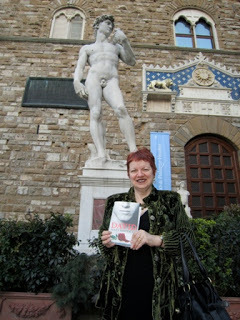 In a brief departure from 'Fairytale Reflections' (which continues this Friday) I'm delighted to welcome back to Steel Thistles the award winning writer Mary Hoffman. Mary writes not only historical fantasy (the marvellous 'Stravaganza' series, published by Bloomsbury) but also 'straight' historical fiction for young adults. I loved her last such book, 'Troubadour' (nominated for the 2010 Carnegie Medal): so it's a pleasure to be part of the blog tour for her new novel - the hero of which is perhaps the most beautiful young man in the world, the model for Michelangelo's famous statue, 'David'.
In a brief departure from 'Fairytale Reflections' (which continues this Friday) I'm delighted to welcome back to Steel Thistles the award winning writer Mary Hoffman. Mary writes not only historical fantasy (the marvellous 'Stravaganza' series, published by Bloomsbury) but also 'straight' historical fiction for young adults. I loved her last such book, 'Troubadour' (nominated for the 2010 Carnegie Medal): so it's a pleasure to be part of the blog tour for her new novel - the hero of which is perhaps the most beautiful young man in the world, the model for Michelangelo's famous statue, 'David'.Beautiful and famous in his day he must have been, but anonymous now. In this novel, Mary has recreated him, led him out of the shadows of history to step forward as Gabrielle, a naive, good-hearted country lad who becomes embroiled in the politics and violence of 16th century Florence and loses his innocence in more ways than one.
Perhaps the very heart of the novel is the chapter in which Gabrielle and his 'milk brother' Angelo journey together to the great quarries of Carrara, to source new marble. For this is not only the story of Gabrielle. It is the story of Michelangelo's stern young 'David', symbol of hope and rebellion: and of the beauty and strength of stone in the hands of genius. And here is Mary to tell you more...
Marble

"Stone! I was born to it, my father, my uncles, every male I knew worked in the quarries. My childhood and youth passed in a haze of stone dust. Even Angelo used to boast that he got his calling from imbibing chisels and mallets with my mother's milk!"
This is what Gabriele says in chapter fourteen of David. He is talking about marble and he and his "milk-brother" Michelangelo are on their way to Carrara to choose twelve pieces of marble for the great sculptor to turn into statues of the Apostles. We can know with hindsight that these statues were never made but neither the younger or the older man has any idea of that when they set off from Florence to the Apuan Alps in search of the pure white blocks they needed.
"They led me inside the mountain, along the sloping floor. The deposits of marble towered on either side of us, like cliffs. Or like the walls of a vast natural cathedral. Walls veined with grey, red and green where minerals had stained the rock. If you half-closed your eyes you could imagine it as a church interior with worked marble columns and floors."
I tried to put myself into the mind of an uneducated country boy from Settignano, who knows about almost nothing but stone, the material he has worked with since he was strong enough to pick up a hammer. The quarries at Settignano are nothing like the famous ones at Carrara and I wanted to convey Gabriele's awe at what he sees, alongside his understanding that they are the very best version of something he already knows.
In the book, this young stonecutter has a bond with the sculptor, not only through the fact that his mother was Michelangelo's wet-nurse but because they both work with stone. I say that neither of them could bear their hands to be sticky or greasy but were content with the chalky, dusty deposits from working with marble. They also have an enormous unslakeable thirst and Michelangelo has a "stonecutter's cough."
In other words I tried to get inside what their daily lives might have been like.
But Gabriele also learns about what is made from those great intractable blocks of marble and the alchemy by which inert matter is translated into art. That is genius. It is a modern use to call someone "a genius.' What would have been said in the Renaissance is that they "had genius" and Gabriele realises that his milk brother does have it.
There is a lot of imagery about stone and marble in the book, not all of it intentional. I found it had just crept in without my realising. I bought a little cube of white Carrara marble in a shop in Pisa and I treasure it for its smooth polish and its satisfying weight. It gives me a glimpse of what it must be like to work this material; much labour and skill went into producing my little cube. How much more into carving the seventeen-foot Giant that is David?
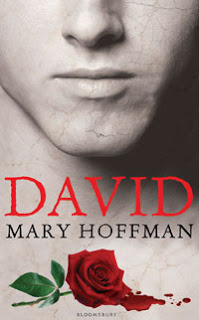
Mary's blog tour continues tomorrow at YA Bookreads - and you can follow her on Twitter and Facebook, and visit her fascinating blog The Bookmaven
Picture credits: Mary and David: Mary Hoffman
Carrara: Trajan's Quarry: John Singer Sargent
Published on July 04, 2011 23:06



